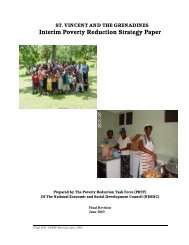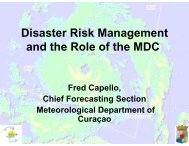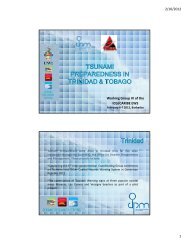The Anatomy of A Silent Crisis The Anatomy of A Silent Crisis
The Anatomy of A Silent Crisis The Anatomy of A Silent Crisis
The Anatomy of A Silent Crisis The Anatomy of A Silent Crisis
- TAGS
- anatomy
- www.bb.undp.org
Create successful ePaper yourself
Turn your PDF publications into a flip-book with our unique Google optimized e-Paper software.
Notes on report methodolog<br />
Assumptions and calculations<br />
• <strong>The</strong> risk factors, which are computed for lives lost, are also applied for the number <strong>of</strong> people<br />
affected. <strong>The</strong> original study describes climate change induced disease burden in terms<br />
<strong>of</strong> number <strong>of</strong> lives lost and disability adjusted life years, (DALYs — a time-based measure<br />
combining years <strong>of</strong> life lost due to premature death and disability, see further details in<br />
Glossary). To estimate the number <strong>of</strong> people affected, this report applies the same risk factors<br />
to the number <strong>of</strong> people seriously affected by disease, such as people who contract malaria,<br />
people suffering from malnutrition, and the number <strong>of</strong> diarrhoea incidences.<br />
• <strong>The</strong> total number affected is assumed to equal the number <strong>of</strong> cases in a given year. For each <strong>of</strong><br />
the three health impacts, this means that: (1) <strong>The</strong> total number <strong>of</strong> people affected by malnutrition<br />
is assumed to be equal to the malnourishment cases over one year, (2) Recorded malaria cases<br />
are assumed to equal the total number affected by malaria each year, and (3) <strong>The</strong> number <strong>of</strong><br />
people affected by diarrhoea is assumed to equal the diarrhoea incidence in a given year.<br />
• Any overlaps, whereby the same individual suffers from multiple cases <strong>of</strong> diarrhoea or malaria<br />
(incidence equals the number <strong>of</strong> new cases per year) are not accounted for, as several cases<br />
can occur in one individual within a year. Reliable global data on the average number <strong>of</strong> cases in<br />
individuals is not available particularly for adult populations who are also significantly affected by<br />
these diseases. On the other hand, incidence does not take into account individuals who suffer<br />
from long term effects due to their illness. In general this leads to the conclusion that incidence<br />
is a better measure <strong>of</strong> those “affected” than alternatives like the number <strong>of</strong> deaths.<br />
• Overlaps could also occur if an individual is afflicted by more than one <strong>of</strong> the three health<br />
impacts (malnutrition, diarrhoea or malaria) within a given year. Any overestimation that this<br />
may lead to is assumed to be <strong>of</strong>fset by potential underreporting <strong>of</strong> overall disease levels,<br />
possible underestimation <strong>of</strong> climate change risk factors and having the health impacts<br />
account for all impacts <strong>of</strong> gradual environmental degradation.<br />
• All health consequences measured refer to the gradual impact <strong>of</strong> climate change and no major<br />
additional gradual onset impacts are left out.<br />
• <strong>The</strong> global disease burden is kept constant as it is assumed that future population growth will<br />
counteract intervention gains.<br />
• <strong>The</strong> climate change scenario used is the mid range <strong>of</strong> the HadCM2 global climate model<br />
(i.e. one <strong>of</strong> several alternative global climate models) used previously by the IPCC.<br />
89







